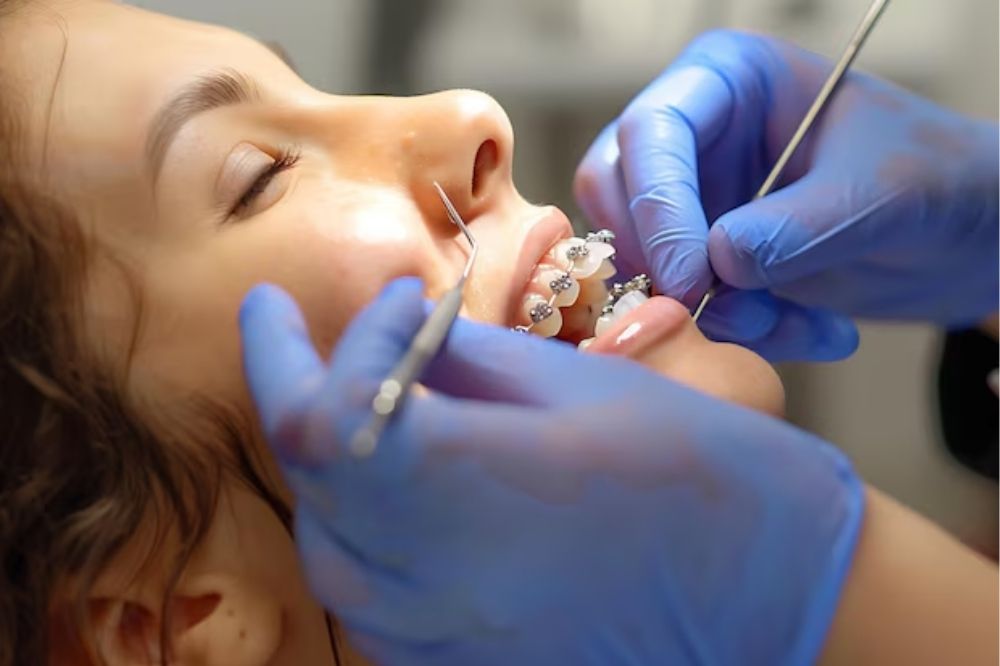Orthodontics goes beyond simply aligning teeth and is beneficial for more comprehensive advanced dental procedures, such as expose and bonding in Gibsonton. An impaction of teeth, mainly of canines, continues to be the most common dental issue, whereby the impacted tooth can be safely guided into its position using the services of an orthodontist, therefore combining both oral surgery and orthodontic treatment.
Let’s look at how orthodontics aids in this procedure and the importance of collaboration between your oral surgeon and orthodontist.
What Are Impacted Teeth?
If a tooth is not able to erupt through the gums when it is supposed to, that tooth is considered to be impacted. In addition to impacted canines, wisdom teeth and baby teeth falling out are also examples of impacted teeth. If not detected, these impacted teeth have the potential to cause crowding, damage nearby roots, and even infections.
In order to treat impacted teeth, you will generally need two procedures called “expose” and “bond.” Once the problem was detected, your dental team began planning the exposure process. One of the first things you should do is to search for a dentist who performs oral surgery near you, as mentioned above, so they can safely expose the tooth that is hidden before the start of the orthodontic treatment.
What Is the Expose and Bonding Procedure?
The expose and bonding procedure is done in three stages, which are the exposure of the impacted tooth (expose) and bonding a small bracket and chain (bonding).
- The chain provides the orthodontist the opportunity to slowly use the gentle force of the chain to ultimately pull it down into position.
- The first part of the procedure is generally done by the oral surgeon, using local anesthesia, and accesses the area where the impacted tooth is hidden.
- After the tooth is exposed, the oral surgeon has done the exposed part of the procedure, and once completed, the orthodontist connects a chain to the braces and attaches the chain to the braces to slowly begin moving the tooth into alignment.
It may sound complex; however, it is a standard collaboration of surgery and ortho, and in some cases, when extreme, the patient may benefit from surgically assisted orthodontics in Gibsonton, which helps move difficult teeth more efficiently by combining surgical support with orthodontic care.
Before and after the expose and dental bonding procedure, your orthodontist prepares your mouth for the treatment.
Orthodontist’s Role Before Surgery
1. Diagnosis and planning
Your orthodontic oral team will take digital X-rays and scans to be aware of the location of the impacted tooth and will follow a plan for tracking its movement over time.
2. Space creation
Your orthodontist will use braces or expanders to control the eruption of the impacted tooth and create proper space prior to referring your treatment to the oral surgeon and returning to orthodontic treatment. Once prepared, your oral surgeon performs the procedure, and the orthodontist continues to manage.
Orthodontist Treatment After Surgery
Once the oral surgeon exposes the impacted tooth and the bracket with chain is bonded, your orthodontist will begin moving the tooth.
1. Controlled tooth movement
Using light pressure from braces, the orthodontist gently pulls the tooth along the chain.
2. Progress and monitoring
Your progress is tracked through regular checkups, ensuring teeth are shifting correctly. In some cases, once the impacted tooth reaches its correct position, cosmetic touch-ups may be done using dental bonding to reshape or improve the appearance of the tooth. This bonding involves applying tooth-colored resin that blends naturally with your smile.
Role of Braces in This Procedure
Braces play a central role in treating impacted teeth. They’re not just for appearance—they are essential in this medical process. Braces for impacted teeth help shift neighbouring teeth, open space, and provide the gentle force needed to guide the impacted tooth downward. They ensure that the tooth lines up correctly with the rest of your bite. This teamwork between braces and oral surgery is what makes exposure and bonding successful.
Benefits of Exposure and Bonding Treatment
This procedure offers long-term benefits for your oral health:
- Saves natural teeth from extraction
- Prevents misalignment and bite issues
- Enhances chewing and speaking function
- Improves smile appearance
- Reduces the risk of future dental problems
By combining surgical accuracy and orthodontic guidance, patients can enjoy a healthier, more balanced smile.
Reveal Your Best Smile—One Tooth At A Time
Don’t let an impacted tooth go unnoticed! Contact Orange Blossom Oral Surgery today to schedule a consultation and take the first step toward a confident, healthy smile. At Orange Blossom Oral Surgery, we specialize in advanced oral and maxillofacial procedures with a focus on patient comfort and precision. Our team is highly trained in surgical techniques like exposure and bonding, wisdom teeth removal, dental implants, and more. We collaborate closely with orthodontists and general dentists to ensure seamless, customized care. With modern technology and a compassionate approach, we’re committed to helping you achieve a healthy, confident smile.


